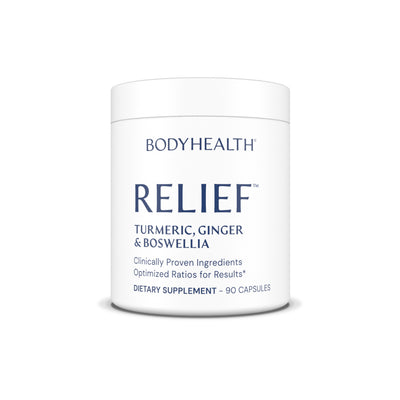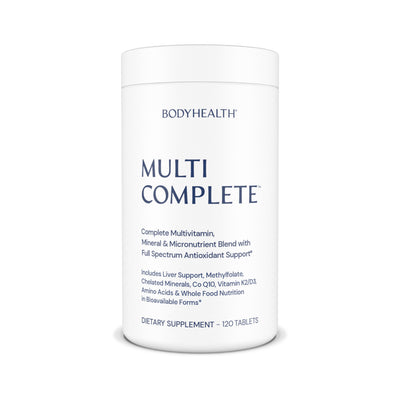How Cortisol Breaks Down Muscle & Prevents Protein Synthesis
March 11, 2025 9 min read

Did you know too high cortisol levels not only build excess body fat, but prevent protein synthesis and actually break down our muscle?
The hormone cortisol is vital to our body, but when levels get too high it can cause us a lot of trouble.
It can raise our stress levels, making us irritated, and cause us to have poor sleep.
It can reduce blood flow, cause lactic acid to build up in our muscles, cause muscle breakdown, and slow muscle recovery.
It lowers our testosterone, growth hormone, and progesterone levels, hormones necessary to build muscle and keep off excess body fat, while raising estrogen levels.
It can damage our cells and increase insulin resistance which then leads to high levels of insulin in the future and higher levels of body fat, especially around our mid-section.
It makes deep sleep, needed for muscle building and fat loss, much harder.
And it causes our hunger hormone, ghrelin, to be released to make us hungry, even when we're not.
In short, we need our cortisol levels properly balanced for muscle building, fat loss, overall health, deep sleep, and the best results possible.
In this article we cover how cortisol works and what we need to do for balanced cortisol levels that allow us to have the body we want.
Let's dive in.
HOW CORTISOL WORKS
If you’ve ever had a shock and felt the adrenaline surge in your body, then you’ve felt cortisol.
It’s a wake-you-up, get-you-ready-for-action hormone.
It hits its lowest point around midnight, so you can sleep, and then peaks about an hour after you’ve gotten up in the morning, getting you to wake up and get ready for the day.
It’s nick-named the “stress hormone” because it’s also released in moments of stress. So in a dangerous situation, or if you get scared suddenly, you’ll feel it.
And it’s important. It’s a hormone we can’t live without… when it’s in balance.
But when it goes out of balance, it can cause us a lot of trouble:
- It raises our stress levels, makes us irritated, and causes us to have poor sleep.
- It reduces blood flow, causes lactic acid to build up in our muscles, causes muscle breakdown, and slows muscle recovery.
- And it lowers our testosterone, growth hormone, and progesterone levels, hormones necessary to build muscle and keep off excess body fat.
- At the same time, it works to lower insulin secretion while simultaneously damaging the cells and increasing insulin resistance (where our cells resist insulin’s message to take in sugar for energy).
- This insulin resistance then leads to high levels of insulin in the future, as your body must release more insulin to get your cells to take in sugar. And, as insulin is also a body fat building hormone, this high insulin leads to higher levels of body fat, especially around the mid-section.
- But insulin resistance also leads to the cells having less energy, which causes the hunger hormone, ghrelin, to be released to make you hungry. You don’t need this food, but as your cells aren’t getting the food that is there, because it’s being converted to body fat, they think you must need more food, so they cause these cravings.
In short, too high cortisol levels can lead to: fatigue, irritability, headaches, intestinal problems such as constipation, bloating or diarrhea, anxiety or depression, increased blood pressure, low libido, erectile dysfunction or problems with regular ovulation or menstrual periods, difficulty recovering from exercise, poor sleep, and muscle pain or tension in the head, neck, jaw, or back
And all of this leads to excess fat that is hard to get rid of, and slow or no gains in building muscle, or even muscle loss.
We’re trying to create either a lean body that is slim and toned and shaped by muscle, or build significant lean muscle without the excess body fat.
High cortisol has no value to us.
So let’s dig into what’s happening here, how cortisol affects muscle building and recovery, and how to prevent high cortisol levels, or lower them when they exist.
CORTISOL BREAKS DOWN MUSCLE & PREVENTS PROTEIN SYNTHESIS
Our body mainly uses fats and sugar for energy. Enzymes break them down, the hormone insulin ushers them to our cells, and our cells take them in and make something called ATP from them, the energy source that cells use.
But with protein, or the amino acids that make up protein, our body is supposed to use this for building and maintaining muscle, bone, hair, hormones and much more.
It’s not supposed to be used for energy, but for building and maintaining our body’s structure.
Cortisol reverses this.
Cortisol is key in emergencies, both short term and long.
In an emergency, which to the body could be anything from a bad injury or just being tired from overwork or lack of sleep, cortisol works to supply your body with energy so you can get out of this situation and survive.
In a war, if your ankle is broken, cortisol helps you get home. It’s vital in emergency situations.
But it also thinks long term. From cortisol’s view, if you’re tired or hurt, then possibly lean times lay ahead. How can you “catch” food to eat if you’re exhausted or hurt?
You can’t. So it’s time to start saving up energy sources. And body fat is the best future energy source there is.
So cortisol sends instructions to turn sugar already in the blood stream or from food that you eat, into body fat, to save for later when there’s no food.
And for energy… it starts breaking down muscle.
If you know the principles behind PerfectAmino, you know what I’m speaking of. Our muscles are made of protein, which is made of amino acids.
And amino acids can be an energy source.
We know that excess amino acids, that the body can’t use to synthesize new protein, go through a process called gluconeogenesis, which breaks the amino acids down, and converts them, in part, to glucose — sugar.
This glucose can then be used as energy.
But cortisol doesn’t get this from excess amino acids. Instead, it gets it from the amino acids that already form the protein in your muscles.
It doesn’t want to use fat stores for energy, it wants to build them for energy in the future.
So instead, it starts breaking your muscle cells apart, to release the proteins in them, and break them down into their individual amino acids to convert to energy.
But this causes muscle loss. And if high cortisol levels continue for long, it can lead to muscle wasting, soreness and exhaustion.
But it also prevents muscle building. Why use amino acids to build new muscle when they’re a good energy source?
We can’t use sugar or fat, they have to be saved for the future.
But we can use amino acids.
So high levels of cortisol also prevent the synthesis of amino acids into protein, so the amino acids can be used for energy.
Without protein synthesis, we can’t repair muscles damaged by workouts. So we not only don’t synthesize new protein to build the muscle, we don’t give new protein to repair what’s already there, so we lose muscle when working out, instead of gaining.
Now, this isn’t a black and white process here. Depending on how much cortisol there is, it may just slow muscle building and recovery, not fully prevent it.
But even that we don’t want.
This is one reason it’s not smart to workout when you get little sleep or are sick.
Not only is your awareness of your environment impaired, so you may make a mistake and injure yourself while working out. But also, your cortisol levels are much higher.
Cortisol was released, due to lack of sleep or exhaustion, to give you energy for the day. So it’s in your bloodstream, in part, already breaking down muscle for energy.
If you work out, you speed up this process by damaging your muscle.
Because, as cortisol is present, protein synthesis for muscle recovery is much slower. And if you’re sick, as the amino acids are needed to make immune cells, muscle recovery may be next to zero.
A workout, in these conditions then, may lead not only to no gains, but losses instead.
If you are sick over have over-trained to and are exhausted, the solution is to increase amino acid intake to fuel fast recovery, not try to cause more injury to the muscles which, in this case, would increase cortisol levels more.
So let’s look at what raises cortisol, and what we can do to lower it when it’s high.
WHAT CAUSES HIGH CORTISOL & HOW DO WE LOWER IT
There are a few main things that raise cortisol levels besides illness, injury, and stress from life. (Yes, life stress — mental stress — also raises cortisol levels.):
Lack of sleep, lack of amino acids to repair muscle damaged in workouts, high sugar levels (which cause inflammation in the blood vessels, causing cortisol to be released), and high omega 6 fatty acids (which raise inflammation levels in the body, thus raising cortisol levels).
As we’ll cover each of these in an article soon, I’m just going to cover them briefly here.
Our processed foods are high in omega 6 fatty acids from corn and soy, the bases of almost all processed foods, and the feed most livestock is fed now.
Omega 6 is used in cells to create pro-inflammatory molecules which raise cortisol.
To combat this we need to remove these processed foods from our diets and only eat meats that are naturally grass-fed, which allows for lower Omega 6 levels and higher Omega 3 levels in the meat.
And lastly, we need to take Omega 3 fatty acids. Omega 3 produces the opposite of what Omega 6 does: anti-inflammatory molecules that lower cortisol.
Next is sugar, especially processed sugars. These raise inflammation in the blood vessels, which releases cortisol. They also raise insulin levels and estrogen levels, which again raise cortisol levels.
And they do us no good. Our body has no real use for them and does not need them. They only cause us harm. So keep to only natural sugars.
Then there is protein and amino acids. When we work out, we damage our muscles. And we need enough protein to help them recover.
If we don’t have enough, then not only do we lose muscle because it’s damaged and can’t be repaired, but also, as this is an injury, cortisol is released. And this cortisol further pushes muscle break-down.
So make sure you’re getting in enough protein and taking your PerfectAmino. And if you feel extra sore or exhausted one day, take more PerfectAmino — your body needs it.
As high cortisol levels deplete vitamins c, a and e in your body, which are necessary for cellular health and recovery, and as vitamin d helps to lower your cortisol levels, it’s important that you’re taking your vitamins daily.
These are needed for real gains and overall health.
Then there is magnesium. This is one mineral that your body vitally needs. It’s actually processed out of most foods these days, so most of us don’t get it naturally.
But it helps to calm our muscles and nerves, help us sleep, remove lactic acid which can cause soreness, and lowers cortisol levels.
So make sure you’re getting in your magnesium.
And finally, sleep.
We need to get our sleep. We’ll have another article covering this, but if you’re having any trouble sleeping, make sure to take our Sleep product to help with this.
And don’t work out on a day when you got bad sleep. Just skip that day. It will be better for gains in the long run.
Not only does lack of sleep cause cortisol levels to rise, and then later prevent sleep, but sleep is also when most of our fat loss and muscle building occurs.
And it doesn’t occur when we have poor sleep.
Okay, that was long, but very important.
Keep pushing hard in your workouts while maintain proper form and stick to your macro ratios, increasing or decreasing them overall as needed.
THE LEAN BODY/LEAN BULK CHALLENGE
If you’re just seeing this and want to know more, check out the Lean Body/Lean Bulk Protocol and Challenge.
It’s very effective at building lean muscle, shaping and toning our body, and all without having the cut or lose excess body fat gained afterwards.
You’ll love it.
And make sure to join our VIP Group where you can ask any question you have and get only the best answers.
I hope this helps.
Index To The Lean Body/Lean Bulk Guide:
Introductory Articles:
Getting Started:
- The Lean Body/Lean Bulk Guide & 30-Day Challenge
- Hormones: The Third Dimension of Calorie Cutting
- The Lean Body/Lean Bulk Diet
Supplements & Macros By Goal:
- Supplements & Macros For Lean Body
- Supplements & Macros For Beginner To Moderate Lean Bulking
- Supplements & Macros For Advanced Lean Bulking
Workout Regimens & Exercise Videos:
- Beginner to Moderate Level Workout Regimen
- Advanced Workout Regimen
- Lean Body/Lean Bulk Exercise Videos
Week One:
- Metrics & Key Data For Week One
- How BCAAs Build Body Fat & Lower Health Over Time
- The Importance Of Complete Protein Digestion
Week Two:
- Dialing In Our Macros For Lean Muscle: Hormones & Cravings
- How Cortisol Breaks Down Muscle & Prevents Protein Synthesis
- How To Improve Growth Hormone, Testosterone & Protein Synthesis
Week Three:
- Thyroid, Estrogen & Progesterone: Speeding Fat Loss & Lean Muscle Creation
- Improving Sleep: Muscle Building, Fat Loss, Mood & Aging
- Maximizing Cellular Function For Endurance & Recovery
Week Four:
- Raising VO2 Max: Endurance, Performance & Recovery
- How Toxins Affect Our Hormones: Building Muscle & Fat Loss
- Blood Flow For Muscle, Fat Loss & Overall Health
Final Week:
Articles by Health Topic
Your Path To Better Health Starts Here!
From in-depth articles on nutritional benefits to updates on new product launches, stay informed and inspired on your journey to optimal health.
*These statements have not been evaluated by the Food and Drug Administration. These products are not intended to diagnose, treat, cure, or prevent any disease.









